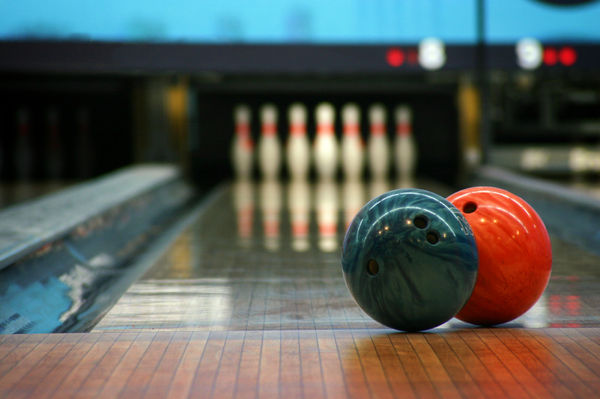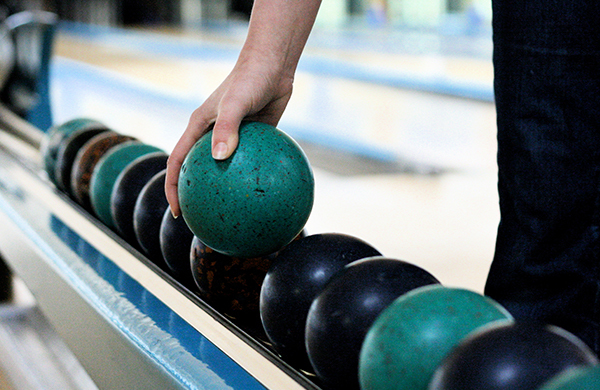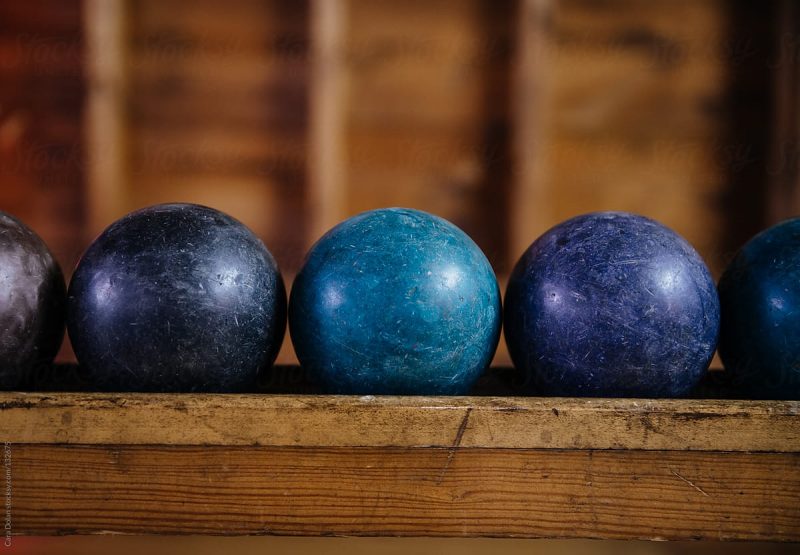Bowling is a well-renowned sport known in different parts of the world. It is an indoor game that serves an individual with not only entertainment but also various other benefits. Like any other sport, bowling also helps in releasing stress and strengthening muscles. It is a fun exercise, a fun activity to do with friends and family. It is not just limited to small gatherings but also worldwide tournaments are held in which expert players take part. Although it seems like a very simple game where you throw the ball on the lane, in the direction of pins, it is actually very technical.
Below are the types of ball used by players depending on their level of expertise in the game.
Types of bowling balls:

img source: wikipedia.org
Beginners use different types of ball that makes it easier for them to practice and on the other hand, an expert player will choose a ball that provides them with the maximum advantage in hitting the ball pins. Choosing a ball also depends on the type of ball pins you want to hit. Stuff used in making different bowling balls also varies. The sizes and mass of balls also vary accordingly. Players choose balls according to their use and experience. Generally, there are low mass and high mass bowling balls. A bowling ball is structured in a way that it has three holes that aid in holding the ball and make it easy to throw it on the lane. Modern-day bowling balls are made of plastic or polyester.
1. Tenpin balls

These are the types of bowling balls that are used on the wooden or synthetic lane. It is very commonly used everywhere and has three holes in it. These types of balls are thrown towards ten pins that are positioned in four equally distant rows. The maximum weight of a ten-pin ball is 16 pounds and has a diameter of at least 8.5 inches.
2. Duck-pin bowling balls

img source: groupon.com
As compared to a ten-pin bowling ball, duck-pin balls are smaller in size. But these balls are larger than candle-pin balls. What makes these balls different from ten-pin balls is their size and moreover they do not consist of any holes to pick them up. Size usually varies from 4.75 to 5 inches. Pins that are knocked down with duck-pin balls are also smaller in size.
3. Candle-pin bowling balls

img source: stocksy.com
These bowling balls are the smallest of all bowling balls. This ball, like a duck-pin ball, has no holes in it. The candlepins are smaller than other ball pins and the size of this ball can be determined by the fact that it can knock down only five balls at a time.
If you’re looking to buy any bowling related equipment, just head over to Bowlerparadise.com and buy the best bowling equipment for your needs.
Coverstocks of bowling balls:
A bowling ball is made of either plastic or polyester. Depending on the type of ball, it may or may not consist of three holes that aid in picking up the ball and dragging it down towards the lane. Another major part of a bowling ball is a coverstock. It is basically the outer shell or cover of the ball. The visible outer layer of the ball that we usually see is known as coverstock.
The main function of this part is to create friction and it defines the efficiency of the game as well. A good coverstock maintains a smooth run of the ball. When a ball is rolled down the lane, the contact between its coverstock and lane raises the friction and increases hook potential. More resistance a coverstock creates more oil is cut down on the lane leading the ball to knock maximum ball pins.
Different materials are being used in making coverstocks of bowling balls. Four types of coverstocks are:
1. Plastic

img source: nationalbowlingacademy.com
A bowling ball with plastic coverstock is mainly used by beginners. Plastic has a smooth surface and this type of coverstock generates less friction which ultimately leads to a decrease in hook potential. Plastic balls are also smaller in size so it helps the learners to carry the ball easily. But for an expert player, these balls are commonly used for practicing.
2. Urethane
After plastic coverstocks, urethane coverstocks have a slightly higher hook potential. They are known to be a little more refined and modernized than plastic balls. When the new learners feel like they need to change the ball and switch towards a little complex pin game, they usually go for urethane coverstock bowling balls. As compared to plastic balls, they have more friction and keep the ball from getting away on the lane.
3. Reactive resin
This is a coverstock bowling ball with very high friction which can lead to some difficulty in managing the ball’s direction. Although, their friction is much better than plastic and urethane balls and is preferred. The pin action of this ball depends on the conditions of the lane. Users of this reactive resin ball are usually those expert players who like to experiment with hook potential as well as they seek lane reactions like what type of throw will lead the ball in a specific direction.
4. Particle/ Proactive coverstock

img source: kiro7.com
This is the most highly recommended type of coverstock bowling ball which is widely used by expert and professional players. The structure of these coverstocks contains slight bumps and has a rough outer surface that produces friction when rolled on the lane. Even if the surface of the bowling lane is oiled heavily, this type of coverstock manages to cut the oil and create resistance. Moreover, it keeps the ball in the direction. These features of particle coverstock make it feasible and best in use.
Final Thoughts
A lot of factors are considered when it comes to bowling. First of all, a player’s expertise decides how the game will go. The players should have a good experience and knowledge about the ball they are using and what angles should be set in order to hit all the pins. Secondly, it depends mainly on the type of ball that the player is using in the game. This is a very important factor and thus you should consider all the ball types mentioned above before buying the ball best suited for you.

